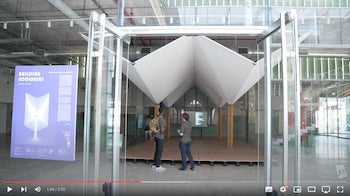A Rice University architect, an engineer and a musician are bringing work that debuted on the other side of the world much closer to home at Post Houston.
The trio — in order, Juan José Castellón, Qilin Li and Kurt Stallmann — have completed a prototype of their cool oasis, “Building Ecologies,” an installation at the former downtown Houston post office that itself was only recently reconfigured as a commercial, art and entertainment space.
Post Houston, a LEED Gold-certified building, is hosting the installation in a gallery near the main lobby until April 20, 2023. Rice’s contribution is part of a Post sustainability event, “There is Only One Earth.”
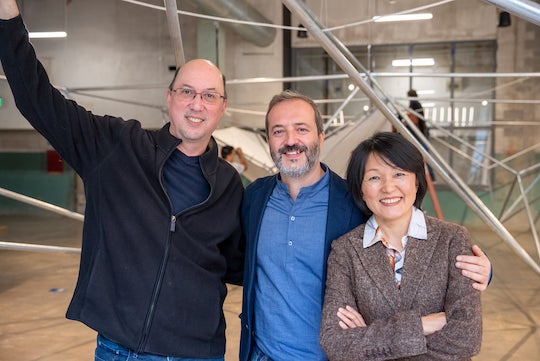
The concept prototyped at Post is circular, though it’s not physically round. It is intended to not only revive the spirits of those who pause there but also make use of its environment by purifying and recycling rainwater to feed plants inside and away from the structure.
The project took root in Castellón’s fall 2020 studio at Rice Architecture. Ultimately, it was built thousands of miles away as he and his eight students presented their work at the 2021 Biennale of Architecture and Urbanism in Seoul, South Korea. The hollow columns that supported the structure, along with the roof’s metal frame and membrane covering, were fabricated in Barcelona, Spain, the best available source of the porous ceramics Castellón required.
Combining the prize-winning design with Li’s groundbreaking solar-powered desalination technology as part of Rice’s Center for Nanotechnology Enabled Water Treatment (NEWT) was planned from the beginning. There’s no rain inside Post, but the installation is a local proof-of-concept for what the team hopes to build at Rice and elsewhere.
“The whole point of this project is to integrate architectural and structural questions with environmental questions,” said Castellón, an assistant professor of architecture.
There’s more to it than meets the eye. When outdoors, the sloping membrane shade will collect and filter water for reuse as conceived by Li, a professor of civil and environmental engineering, materials science and nanoengineering and of chemical and biomolecular engineering and also co-director of NEWT.
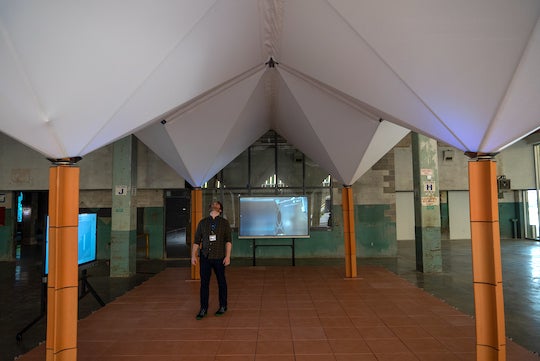
The membranes are treated with nanoparticles to destroy microbes that might otherwise foul water that flows through the columns to storage under the raised floor.
“This overcomes the usual problems related to storing rainwater in a cistern by avoiding microbial growth and allowing for post-treatment of the water,” Li said. “Then we can directly use it to irrigate landscape or for other purposes.
“The original idea was to put this structure on a roof at Rice, and we thought this would be a good way to water the rooftop garden,” she said. “The water would be safe and you wouldn’t have to worry about maintenance of the storage and pipe system.”
Castellón said the columns themselves could eventually serve as a filtration device. He’s also in discussions with Rice’s Carbon Hub to test carbon nanotube fibers as part of a tensioning system to account for wind loads outdoors. “We don’t have to deal with that for the first prototype, but it will be an additional challenge,” he said.
Though water will not flow at Post, visitors will sense it thanks to Stallmann, a composer and professor of composition and theory at Rice’s Shepherd School of Music. Stallmann and Castellón met when the latter became interested in his virtual reality installation at the Moody Center for the Arts. That led to a conversation about the Post project.
“He came to my office to look at the hollow columns we fabricated in Barcelona and said, ‘You know, this could be an instrument,’” Castellón said.
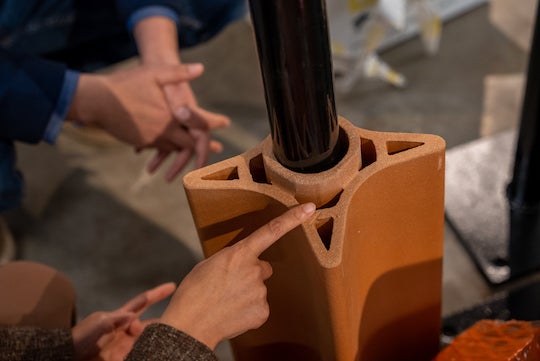
At Post, hanging speakers feed the synthesized sound of rain into the columns. “We hope we can activate the posts that way,” said Stallmann, who also directs the Rice Electroacoustic Music Labs at the Shepherd School. He also planned to conceal transducers in the floor to vibrate the lower part of the structure.
Getting the vibe just right was a challenge, he said, because nobody knew what the rain would sound like as it flowed through the columns. “Once they get funneled through the canvasses into the tubes and the tubes resonate, there’s a transformation from a kind of noise into a kind of pitch that happens just naturally as part of the structure,” he said. “That’s what we’re trying to capture.”
That aligns with his usual strategy of taking sounds he records in the wild — the call of an urban street vendor in China or the sounds of Houston, including the roar of Hurricane Rita — and working them into his scores.
“Evoking the idea of rain streaming inside the columns has been a really fascinating experience for me, because it changes and expands my understanding of holistic design,” Castellón said. “I’m always thinking about holistic design, but in the realm of architecture, materials science, structural systems and building systems. However, sound and light are also integral to making it complete.”
- Video
-
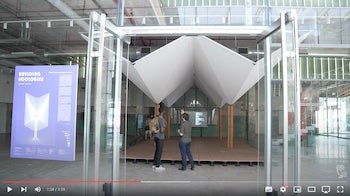
Video produced by Brandon Martin/Rice University
- Images for download
-
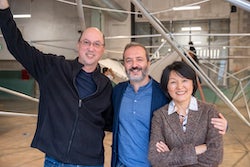
https://news-network.rice.edu/news/files/2022/10/1031_POST-1-WEB.jpg
From left, Rice University’s Kurt Stallmann, a professor of composition and theory, Juan José Castellón, an assistant professor of architecture, and Qilin Li, a professor of civil and environmental engineering, are collaborators on “Building Ecologies,” an installation at the former downtown Houston post office. (Credit: Brandon Martin/Rice University)
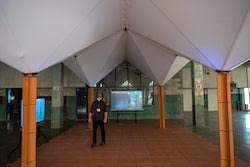
https://news-network.rice.edu/news/files/2022/11/1031_POST-5-web.jpg
“Building Ecologies” at Post Houston, a prototype by Rice University faculty members, demonstrates a “circular” strategy that incorporates environmental systems into architecture. The installation is open to the public through April 20. (Credit: Brandon Martin/Rice University)
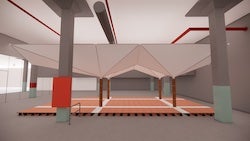
https://news-network.rice.edu/news/files/2022/10/1031_POST-3-web.jpg
A rendering shows the bare-bones version of “Building Ecologies,” an installation at Post Houston by Rice University collaborators. Their aim is to demonstrate “circular” architecture that provides shade while purifying and recycling rainwater for plants. (Credit: Juan José Castellón, Van Pham, Michael Xu and Candela Cicinelli/Rice Architecture)
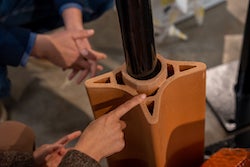
https://news-network.rice.edu/news/files/2022/10/1031_POST-4-web.jpg
A module of the ceramic columns that supports Rice University’s installation at Post Houston. Faculty members are installing “Building Ecologies” to demonstrate a “circular” strategy that incorporates environmental systems into architecture. (Credit: Brandon Martin/Rice University)
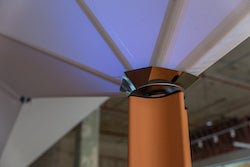
https://news-network.rice.edu/news/files/2022/11/1031_POST-6-web.jpg
The membrane roof of “Building Ecologies,” a Rice University installation, feeds into ceramic posts that will carry water to storage underneath the floor in an outdoor installation. That water, purified by the membranes above, can then be used to feed plants in and around the shelter. The project demonstrates a “circular” strategy that incorporates environmental systems into architecture. (Credit: Brandon Martin/Rice University)
- Related materials
-
Architecture studio wins honors in Seoul: https://news.rice.edu/news/2021/architecture-studio-wins-honors-seoul
Next fall, Rice Architecture sets sail for Seoul: https://news.rice.edu/news/2020/next-fall-rice-architecture-sets-sail-seoul
Rice engineers: Make wastewater drinkable again: https://news.rice.edu/news/2020/rice-engineers-make-wastewater-drinkable-again
DOE funds field test of Rice’s solar desalination: https://news2.rice.edu/2018/06/25/doe-funds-field-test-of-rices-solar-desalination-technology/
Industrial-strength brine, meet your kryptonite: https://news.rice.edu/news/2020/industrial-strength-brine-meet-your-kryptonite
Xmade (Castellón’s practice website): https://xmade.eu
Li Research Lab: https://qilinli.rice.edu
Stallmann bio: https://music.rice.edu/faculty/kurt-stallmann
- About Rice
-
Located on a 300-acre forested campus in Houston, Rice University is consistently ranked among the nation’s top 20 universities by U.S. News & World Report. Rice has highly respected schools of Architecture, Business, Continuing Studies, Engineering, Humanities, Music, Natural Sciences and Social Sciences and is home to the Baker Institute for Public Policy. With 4,240 undergraduates and 3,972 graduate students, Rice’s undergraduate student-to-faculty ratio is just under 6-to-1. Its residential college system builds close-knit communities and lifelong friendships, just one reason why Rice is ranked No. 1 for lots of race/class interaction and No. 1 for quality of life by the Princeton Review. Rice is also rated as a best value among private universities by Kiplinger’s Personal Finance.

